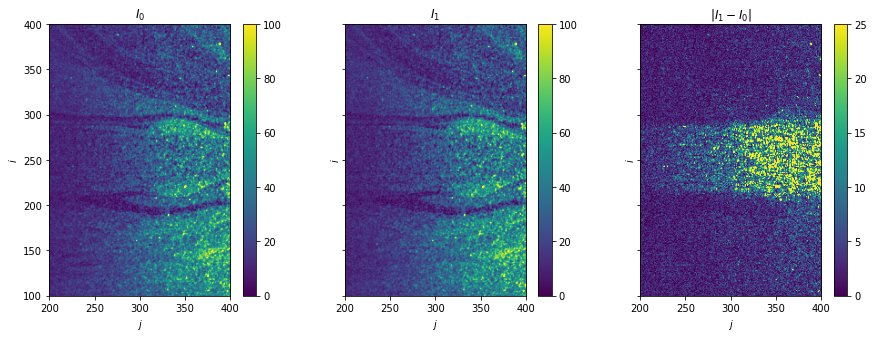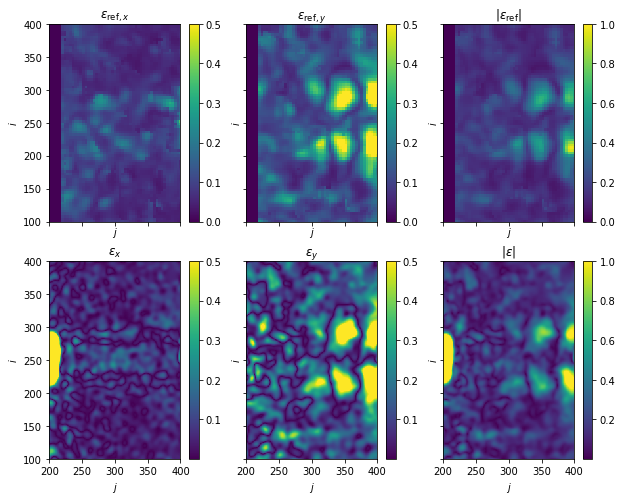Disparity calculation using Iterative Lucas-Kanade
Description
Disparity calculation using optical flow registration technique, Iterative Lucas-Kanade [source].
Setup
Packages
[1]:
%reload_ext autoreload
%autoreload 2
[2]:
import matplotlib.pyplot as plt
import numpy as np
import os
import pivuq
Load images
[3]:
parent_path = "./data/particledisparity_code_testdata/"
image_pair = np.array(
[plt.imread(os.path.join(parent_path + ipath)).astype("float") for ipath in ["B00010.tif", "B00011.tif"]]
)
Plot raw data
[4]:
fig, axes = plt.subplots(ncols=3, sharex=True, sharey=True, figsize=(15, 5))
for i, ax in enumerate(axes[:2]):
im = ax.imshow(image_pair[i], vmax=100)
fig.colorbar(im, ax=ax)
ax.set(title=f"$I_{i}$")
ax = axes[-1]
im = ax.imshow(np.abs(image_pair[1] - image_pair[0]), vmin=0, vmax=25)
fig.colorbar(im, ax=ax)
ax.set(title="$|I_1 - I_0|$")
for ax in axes:
ax.set(xlim=(200, 400), ylim=(100, 400), xlabel="$j$", ylabel="$i$")

Load reference velocity and disparity
[5]:
data = np.loadtxt(os.path.join(parent_path + "B00010_UQ.dat"), skiprows=3).T
I, J = 128, 128
X_ref = np.reshape(data[0], (I, J)) - 1 # zero-index
Y_ref = np.reshape(data[1], (I, J)) - 1
U_ref = np.stack((np.reshape(data[2], (I, J)), np.reshape(data[3], (I, J))))
e_ref = np.stack((np.reshape(data[4], (I, J)), np.reshape(data[5], (I, J))))
N_ref = np.reshape(data[6], (I, J))
window_size = X_ref[0][1] - X_ref[0][0]
Plot reference velocity and disparity
[6]:
fig, axes = plt.subplots(ncols=5, sharex=True, sharey=True, figsize=(20, 5))
ax = axes[0]
im = ax.pcolormesh(X_ref, Y_ref, np.linalg.norm(U_ref, axis=0))
fig.colorbar(im, ax=ax)
ax.set(title=r"$|U|$")
for i, (ax, var) in enumerate(zip(axes[1:4], [r"\epsilon_{\mathrm{ref},x}", r"\epsilon_{\mathrm{ref},y}"])):
im = ax.pcolormesh(X_ref, Y_ref, e_ref[i], vmax=0.5)
fig.colorbar(im, ax=ax)
ax.set(title=f"${var}$")
ax = axes[3]
im = ax.pcolormesh(X_ref, Y_ref, np.linalg.norm(e_ref, axis=0))
fig.colorbar(im, ax=ax)
ax.set(title=r"$|\epsilon_{\mathrm{ref}}|$")
ax = axes[4]
im = ax.pcolormesh(X_ref, Y_ref, N_ref)
fig.colorbar(im, ax=ax)
ax.set(title=r"$N$")
for ax in axes.ravel():
ax.set(xlim=(200, 400), ylim=(100, 400), xlabel="$j$", ylabel="$i$")

Disparity calculation
[7]:
%%time
X, Y, e = pivuq.disparity.ilk(
image_pair,
U_ref,
window_size=16,
window="gaussian",
velocity_upsample_kind="linear",
warp_direction="center",
warp_order=1,
warp_nsteps=1,
)
CPU times: user 2.31 s, sys: 50 ms, total: 2.36 s
Wall time: 2.37 s
Plot: Disparity map - Reference vs. ILK
[8]:
fig, axes = plt.subplots(nrows=2, ncols=3, sharex=True, sharey=True, figsize=(10, 8))
for i, (ax, var) in enumerate(zip(axes[0, :3], [r"\epsilon_{\mathrm{ref},x}", r"\epsilon_{\mathrm{ref},y}"])):
im = ax.pcolormesh(X_ref, Y_ref, e_ref[i], vmax=0.5)
fig.colorbar(im, ax=ax)
ax.set(title=f"${var}$")
ax = axes[0, -1]
im = ax.pcolormesh(X_ref, Y_ref, np.linalg.norm(e_ref, axis=0), vmax=1)
fig.colorbar(im, ax=ax)
ax.set(title=r"$|\epsilon_{\mathrm{ref}}|$")
for i, (ax, var) in enumerate(zip(axes[1, :3], [r"\epsilon_x}", r"\epsilon_y}"])):
im = ax.pcolormesh(X, Y, e[i], vmax=0.5)
fig.colorbar(im, ax=ax)
ax.set(title=f"${var}$")
ax = axes[1, -1]
im = ax.pcolormesh(X, Y, np.linalg.norm(e, axis=0), vmax=1)
fig.colorbar(im, ax=ax)
ax.set(title=r"$|\epsilon|$")
for ax in axes.ravel():
ax.set(xlim=(200, 400), ylim=(100, 400), xlabel="$j$", ylabel="$i$")
